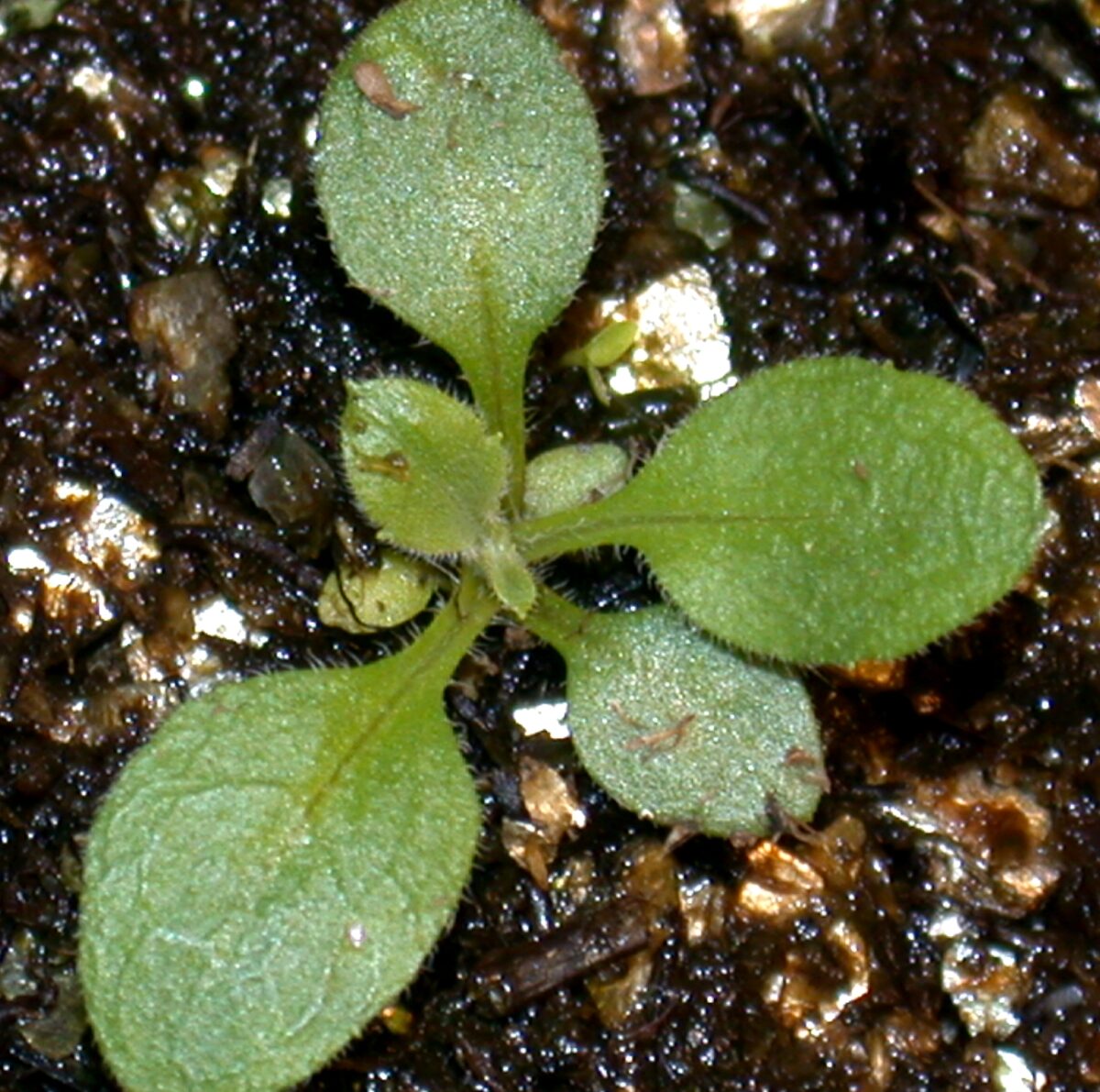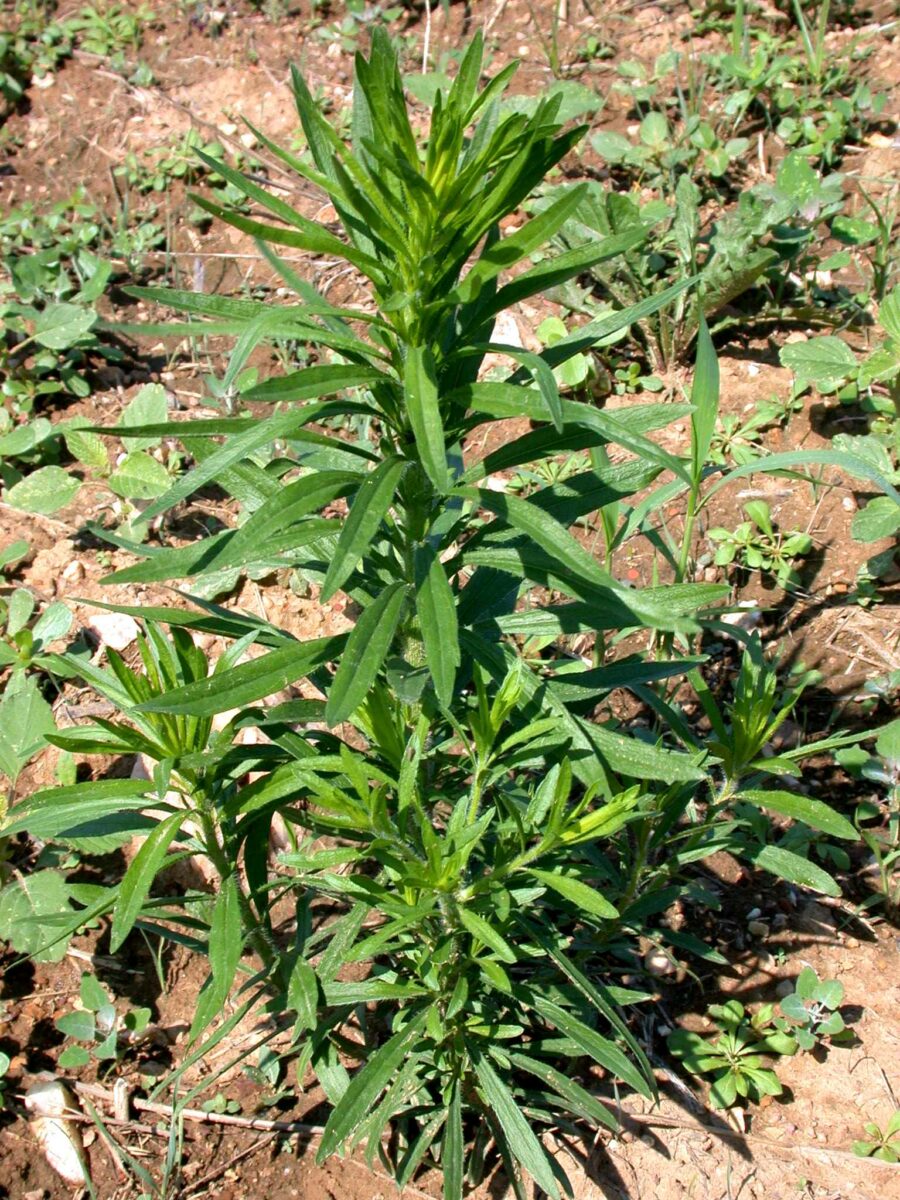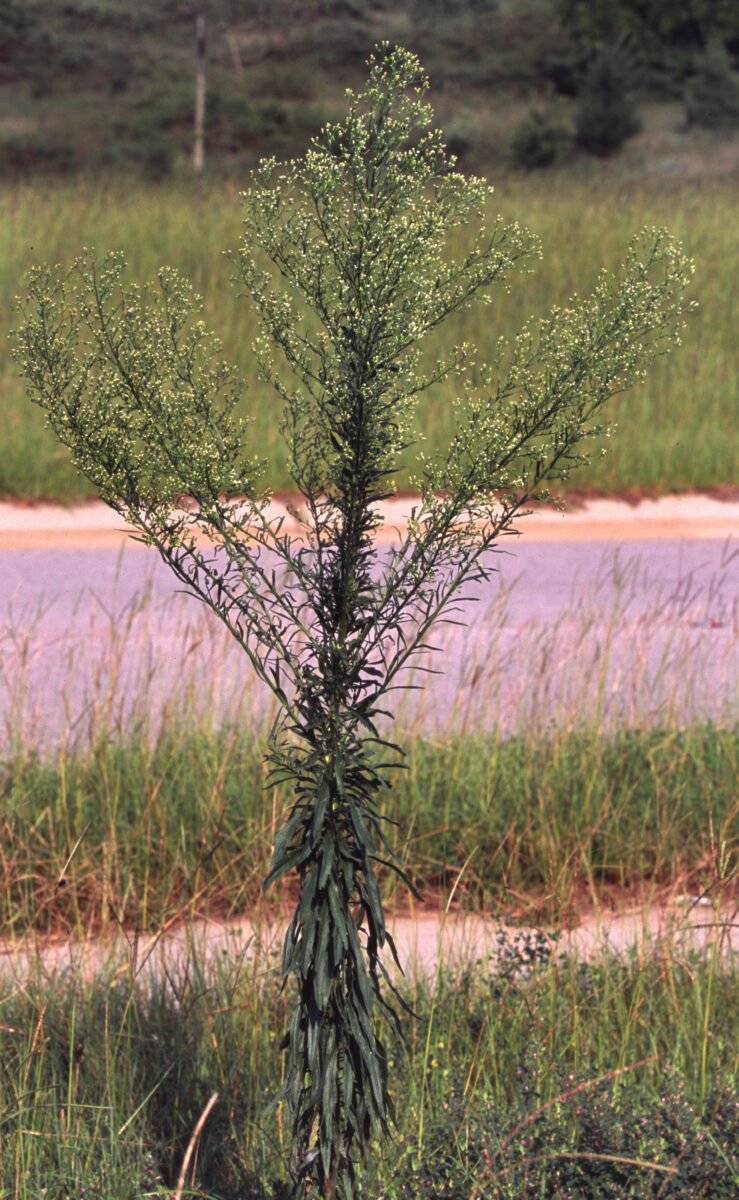Other common names: blood stanch, butterweed, Canada fleabane, colt’s tail, fireweed, hogweed, mare’s tail, pride weed, flea wort, mule tail, fleabane, bitterweed, Canadian fleabane, stickweed



Conyza canadensis (L.) Cronquist = Erigeron canadensis L.
Identification of Horseweed
Family: Aster family, Asteraceae
Habit: Erect, winter or summer annual herb with densely leafy, essentially unbranched stalks
Description: Short hairs give horseweed seedlings a fuzzy appearance. Cotyledons are small, 0.1 inch long and egg shaped. Young leaves are oval, toothed, hairy and arranged in a basal rosette. Leaves at the rosette base have distinct stalks, and upper leaves taper to the rosette base. Toothed leaf edges become deeper with age. A short taproot is supplemented by a fibrous root system. Seedlings emerging in the spring form basal rosettes, yet produce only a few leaves, and soon after emergence these plants begin to bolt. Mature plants bolt on a single stem that can reach 1–6 feet in height. The basal rosette frequently disintegrates when plants mature. Stems are covered with bristly, short hairs and many closely spaced, hairy, alternately arranged, downward angled, baseball-bat-shaped leaves measuring 4 inches long by 0.4 inch wide. Toothing, when present, is widely spaced and shallow. The leaf tip has two small, uneven indentations located across from one another. The upper stem branches produce a panicle of small, 0.2 inch diameter, white, daisy-like flower heads. These consist of 25–50 white to pink-tinged, one-petaled flowers along the edge surrounding 7–12 small, yellow, knobby disk flowers. At the base of each flower head are one to two rows of small, green bracts. The outer coat of the seed is a thin dry layer of fruit tissue. Seeds are brown, torpedo shaped and attached to a pappus of bristly hairs. Seed length, not including the pappus, is less than 0.1 inch.
Similar species: Hairy fleabane [Conyza bonariensis (L.) Cronquist] is shorter, branched from the base and has densely hairy gray-green leaves. Its ray flowers are greenish-yellow rather than white, and its disc flowers are inconspicuous and white rather than yellow. Annual fleabane [Erigeron annuus (L.) Pers.] and rough fleabane (Erigeron strigosus Muhl. ex Willd.) are similar to horseweed at all stages. Annual fleabane flower heads are two to three times larger in diameter than those of horseweed. The stem has ridges and branches, and the leaves are more distinctly toothed. Rough fleabane leaves are paddle shaped and have hairs that lie parallel to the leaf surface.
Management of Horseweed
The keys to controlling horseweed are tillage, crop competition and management of the species in areas around fields. Horseweed rosettes are easily destroyed by spring tillage, which is why the species is most frequently found in overwintering crops like strawberries and winter or no-till grain crops. Moreover, plow tillage that buries the previous year’s seeds will permanently eliminate nearly all of them since most will die before subsequent tillage returns them to the soil surface environment that they need for establishment. Since new seedlings arise at the soil surface and are slow to establish, they are easily killed by tine weeding in field crops and by precision weeding tools and hoeing in vegetable crops. However, plants become difficult to control with tine weeding in late spring because of rapid growth at this time.
Horseweed is sensitive to crop competition, so steps that increase crop competitiveness can greatly reduce horseweed problems (see Chapter 3 for methods). Spring germinating horseweed can be a problem in weakly competitive crops like carrots and onions. To avoid problems in these crops, precede them with two years of highly competitive or short season crops in which horseweed is suppressed and prevented from going to seed. A rye or forage radish cover crop that establishes a leaf canopy quickly in fall can effectively suppress establishment of this species.
Since horseweed reproduces prolifically and the seeds blow easily into surrounding fields, cleaning up waste ground to prevent seed production is critical. Plant stream sides, banks of irrigation ditches, edges of equipment yards and other potentially weedy habitats with competitive species that suppress horseweed. Mowing will usually not completely eliminate seed production because new sprouts will grow from dormant buds. Mowing greatly reduces seed production, however, and lowers the launching point so that seeds cannot blow as far. If horseweed has not yet gone to seed at harvest, be sure to clean up the field afterward with disking or other appropriate tillage.
Even low rates of organic mulch effectively suppress horseweed if placed before seedlings begin to bolt, probably because energy reserves in the seed are negligible and the seedlings are tiny and weak. Horseweed is especially sensitive to rye straw, which releases toxins that poison the seedlings in addition to casting shade. Consequently, straw mulch can be very effective for suppressing horseweed in crops where spring tillage is not an option, like strawberries and garlic.
Ecology of Horseweed
Origin and distribution: Horseweed is native to North America but is probably much more widespread now than prior to European settlement. It occurs throughout southern Canada, the entire United States, Mexico and much of Latin America. It is widely naturalized in Europe, temperate and tropical Asia, Australia, New Zealand and southern Africa.
Seed weight: 0.032–0.072 mg.
Dormancy and germination: Most seeds are not dormant when dispersed from the parent plant. Chilling is not required for germination. Light is the primary requirement for germination of most populations. Seeds germinate best at day/night temperatures of 68/50°F to 86/68°F. No seeds germinated at 54/43°F. The lowest continuous temperature giving maximum germination was 63°F. The base temperature for germination ranged from 49°F for a population from Ontario to 57°F for a population from Spain.
Seed longevity: Horseweed seeds are generally short-lived in the soil. Horseweed soil seed populations declined by 76% in 10 months from October to August, but 6% of the seeds remained after two years of good weed control. Horseweed is present in seed banks of pastures where the plant has not been present above ground for many years, and it was the most abundant species in the seed bank after 12 years of a tillage experiment, suggesting that a portion of seeds may last for several years in the soil. However, these observations could be complicated by seeds that blew in from elsewhere, and long-distance seed dispersal is probably more important for survival of this species than seed longevity (see the section “Dispersal”).
Season of emergence: Many plants emerge in the fall and overwinter as a rosette of leaves. Other plants emerge in the spring, and a few seedlings may emerge throughout the summer. Emergence was reported as greatest in fall in cooler climates such as Canada and the upper midwestern United States, and it was greatest in spring in milder climates such as Indiana and southern Sweden. The lack of seed dormancy means that microsite conditions play an important role in determining whether horseweed functions as a winter or summer annual species. In Tennessee emergence occurred during months when daytime temperatures were between 50–60°F, leading to peak emergence in the fall at some sites and in the spring at other sites.
Emergence depth: Seedling emergence declines very rapidly with depth of burial. The majority of the seedlings emerge from seeds at the soil surface. In one experiment, only 4% as many seeds emerged from 0.1 inch as emerged from seeds placed on the soil surface, and no seedlings emerged from greater depths. In another experiment, 10% emerged from 0.4 inch.
Photosynthetic pathway: C3
Sensitivity to frost: Winter annual horseweed plants tolerate frost well and overwinter as a rosette of leaves, even in very cold climates. During sunny winter weather, leaf temperature may be as much as 18°F above air temperature, and leaves photosynthesize actively. Plant survival in Iowa and Minnesota ranged from 59–91%, with higher survival rates associated with larger rosettes before winter. However, in southern Indiana, only plants with small rosettes survived winter, and their survival rate was only 24%. Likewise, in Sweden few rosettes were found to survive winter. The principle cause of winter mortality is frost heaving, but the specific interactions between soil conditions and rosette size remain unresolved. Possibly, rosettes survive better in regions with continuously cold conditions and a snowpack than in regions with alternating freezing and thawing temperatures.
Drought tolerance: Horseweed tolerates drought well.
Mycorrhiza: Horseweed is mycorrhizal.
Response to fertility: Horseweed commonly colonizes badly eroded, abandoned farmland, which indicates a tolerance of low soil fertility and limited response to applied nitrogen.
Soil physical requirements: Horseweed occurs most commonly on sandy, stony or loam soils with good drainage. It does not tolerate flooding. Seeds will germinate in salty environments.
Response to shade: Horseweed growth is stunted by shading from crops or other weeds.
Sensitivity to disturbance: Overwintering rosettes of horseweed are easily killed by spring tillage, and the species is generally rare or absent from spring tilled fields. Slow development of the seedling makes the species easily controlled by tine weeding, raking or hoeing. Mowing prevents or delays seed production.
Time from emergence to reproduction: Flower stalks of overwintering plants begin elongating in mid-spring and flower about two to three months later. Seeds mature 10 days to three weeks after pollination. Seed production continues for several weeks. Spring emerging plants rapidly pass through a rosette phase resulting in shorter time to bolting and flowering than fall emerging plants.
Pollination: Pollen is released before the flowers fully open, which promotes extensive self-pollination. Insects regularly visit the flowers, however, and the outcrossing rate for an Ontario population was estimated at 4%.
Reproduction: Flower heads typically produce 35–70 seeds each. The number of flowers produced by a plant depends on plant height. Thus, fall emerging plants 16 inches tall produced about 2,000 seeds whereas plants 5 feet tall produced about 230,000 seeds. Uncrowded plants on fallow ground produce about 200,000–400,000 seeds each. On the other hand, spring emerging, glyphosate-resistant plants growing within a crop canopy had a maximum production of only 10,000–60,000 seeds per plant. Plants emerging earliest, either in the fall or spring, had the highest survival rate and produced the most seeds.
Dispersal: The tiny, plumed seeds stayed aloft longer than those of 19 species tested in a controlled seed drop experiment. Although the majority of seeds remain within 330 feet of the source plant, dispersal distances of up to 1,640 feet were documented. Some seeds that ascend into the atmosphere by turbulence could be carried 75 miles or more. Seeds float well on water and probably disperse long distances in streams and irrigation canals. The plumed seeds are also caught by and carried on vehicles.
Common natural enemies: Aster yellows mycoplasma can decrease seed production by over 50%.
Palatability: The species is not eaten by people. It is little used by livestock and is irritating to horses.
Note: Horseweed can produce allelopathic compounds that inhibit forage species including orchardgrass, white clover and alfalfa under controlled environments. However, numerous crops have shown no adverse influences when seeded into terminated stands of horseweed under field conditions.
Summary Table of Horseweed Characteristics
| Horseweed | ||||||||
|---|---|---|---|---|---|---|---|---|
| Growth habit | Seed weight (mg) | Seed dormancy at shedding | Factors breaking dormancy | Optimum temperature for germination (F) | Seed mortality in untilled soil (%/year) | Seed mortality in tilled soil (%/year) | Typical emergence season | Optimum emergence depth (inches) |
| medium, erect | 0.03–0.07 | No | li | 68/50 to 86/68 | 76 | na | fall and spring | 0–0.1 |
| Photosynthesis type | Frost tolerance | Drought tolerance | Mycorrhiza | Response to nutrients | Emergence to flowering (weeks) | Flowering to viable seed (weeks) | Pollination | Typical & high seed production (seeds per plant) |
| C3 | high | high | yes | low | 8–12 | 2–3 | self, can cross | 50,000 & 300,000 |
Table Key
General: The designation “–” signifies that data is not available or the category is not applicable.
Growth habit: A two-word description; the first word indicates relative height (tall, medium, short, prostrate) and second word indicates degree of branching (erect, branching, vining).
Seed weight: Range of reported values in units of “mg per seed.”
Seed dormancy at shedding: “Yes” if most seeds are dormant when shed, “Variable” if dormancy is highly variable, “No” if most seeds are not dormant.
Factors breaking dormancy: The principle factors that are reported to break dormancy and facilitate germination. The order of listing does not imply order of importance. Abbreviations are:
scd = seed coat deterioration
cms = a period subjected to cold, moist soil conditions
wst = warm soil temperatures
li = light
at = alternating day-night temperatures
ni = nitrates
Optimum temperature range for germination: Temperature (Fahrenheit) range that provides for optimum germination of non-dormant seeds. Germination at lower percentages can occur outside of this range. The dash refers to temperature range, and the slash refers to alternating day/night temperature amplitudes.
Seed mortality in untilled soil: Range of mortality estimates (percentage of seed mortality in one year) for buried seeds in untilled soil. Values were chosen where possible for seeds placed at depths below the emergence depth for the species and left undisturbed until assessment. Mortality primarily represents seed deterioration in soil.
Seed mortality in tilled soil: Range of mortality estimates (percentage of seed mortality in one year) for seeds in tilled soil. Values were chosen for seeds placed within the tillage depth and subjected to at least annual tillage events. Seed losses are the result of dormancy-breaking cues induced by tillage, germination and deterioration of un-germinated seeds.
Typical emergence season: Time of year when most emergence occurs in the typical regions of occurrence for each weed. Some emergence may occur outside of this range.
Optimum emergence depth: Soil depths (in inches below the soil surface) from which most seedlings emerge. Lower rates of emergence usually will occur at depths just above or just below this range.
Photosynthesis type: Codes “C3” or “C4” refer to the metabolic pathway for fixing carbon dioxide during photosynthesis. Generally, C3 plants function better in cooler seasons or environments and C4 plants function better in warmer seasons or environments.
Frost tolerance: Relative tolerance of plants to freezing temperatures (high, moderate, low).
Drought tolerance: Relative tolerance of plants to drought (high, moderate, low).
Mycorrhiza: Presence of mycorrhizal fungi. “Yes” if present; “no” if documented not to be present, “unclear” if there are reports of both presence and absence; “variable” if the weed can function either with or without, depending on the soil environment.
Response to nutrients: Relative plant growth response to the nutrient content of soil, primarily N, P, K (high, moderate, low).
Emergence to flowering: Length of time (weeks) after emergence for plants to begin flowering given typical emergence in the region of occurrence. For species emerging in fall, “emergence to flowering” means time from resumption of growth in spring to first flowering.
Flowering to viable seed: Length of time (weeks) after flowering for seeds to become viable.
Pollination: “Self” refers to species that exclusively self-pollinate, “cross” refers to species that exclusively cross-pollinate, “self, can cross” refer to species that primarily self-pollinate, but also cross-pollinate at a low rate, and “both” refers to species that both self-pollinate and cross-pollinate at relatively similar rates.
Typical and high seed production potential: The first value is seed production (seeds per plant) under typical conditions with crop and weed competition. The second value, high seed production, refers to conditions of low density without crop competition. Numbers are rounded off to a magnitude that is representative of often highly variable reported values.
Further Reading
Buhler, D.D. and M.D.K. Owen. 1997. Emergence and survival of horseweed (Conyza canadensis). Weed Science 45: 98–101.
Davis, V.M. and W.G. Johnson. 2008. Glyphosate-resistant horseweed (Conyza canadensis) emergence, survival, and fecundity in no-till soybean. Weed Science 56: 231–236.
Weaver, S.E. 2001. The biology of Canadian weeds. 115. Conyza canadensis L. Cronquist. Canadian Journal of Plant Science 81: 867–875.

